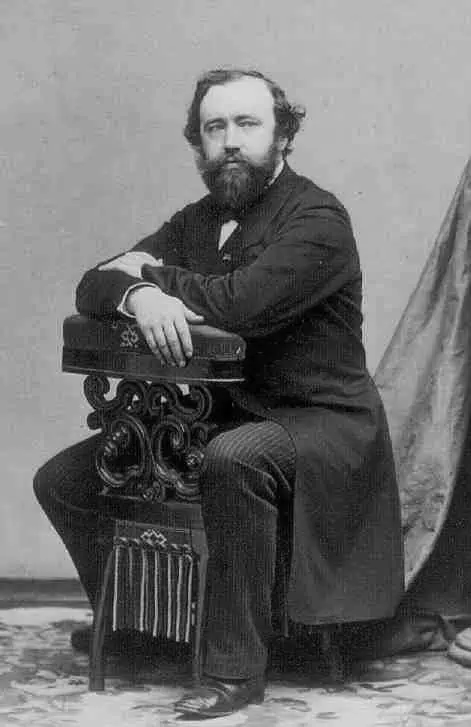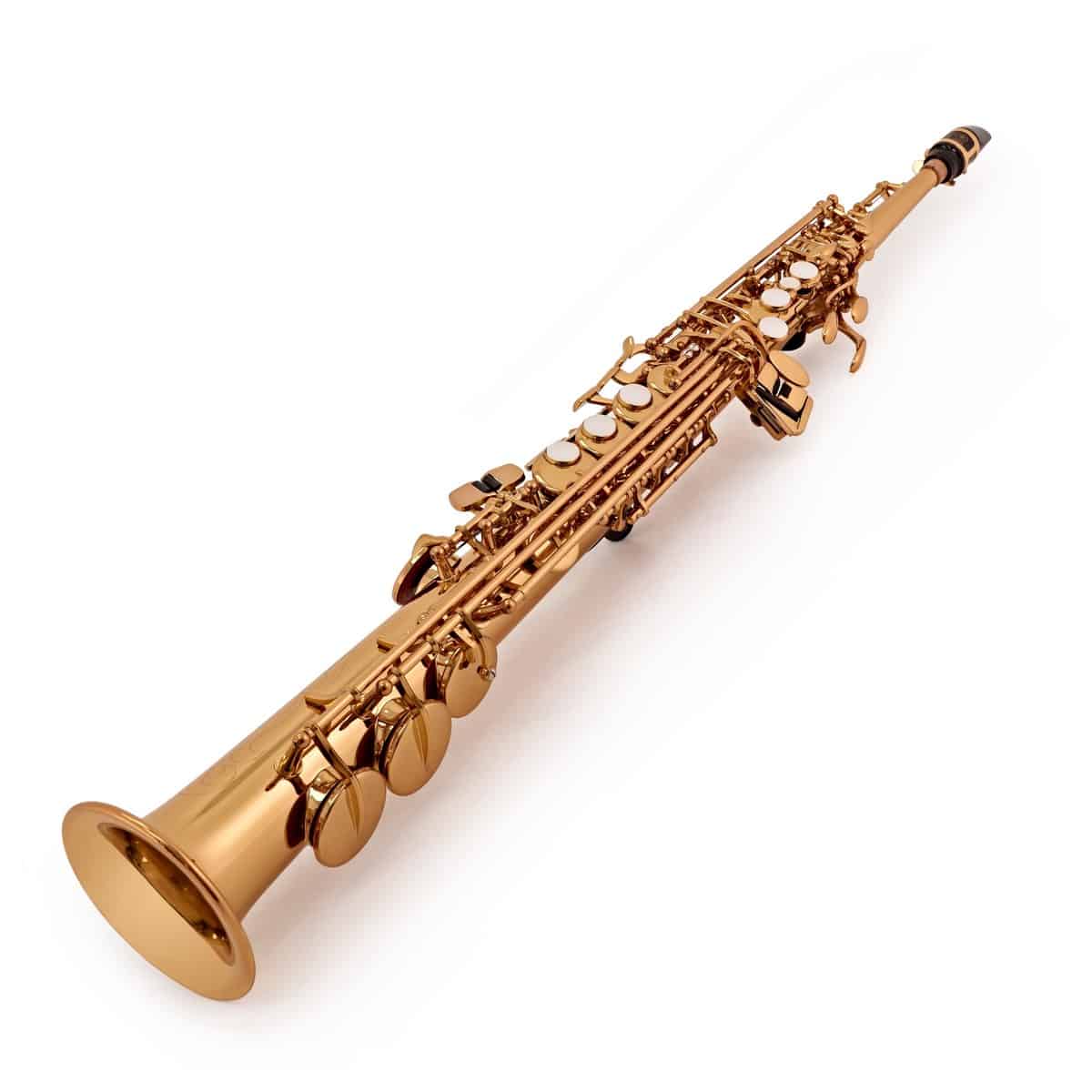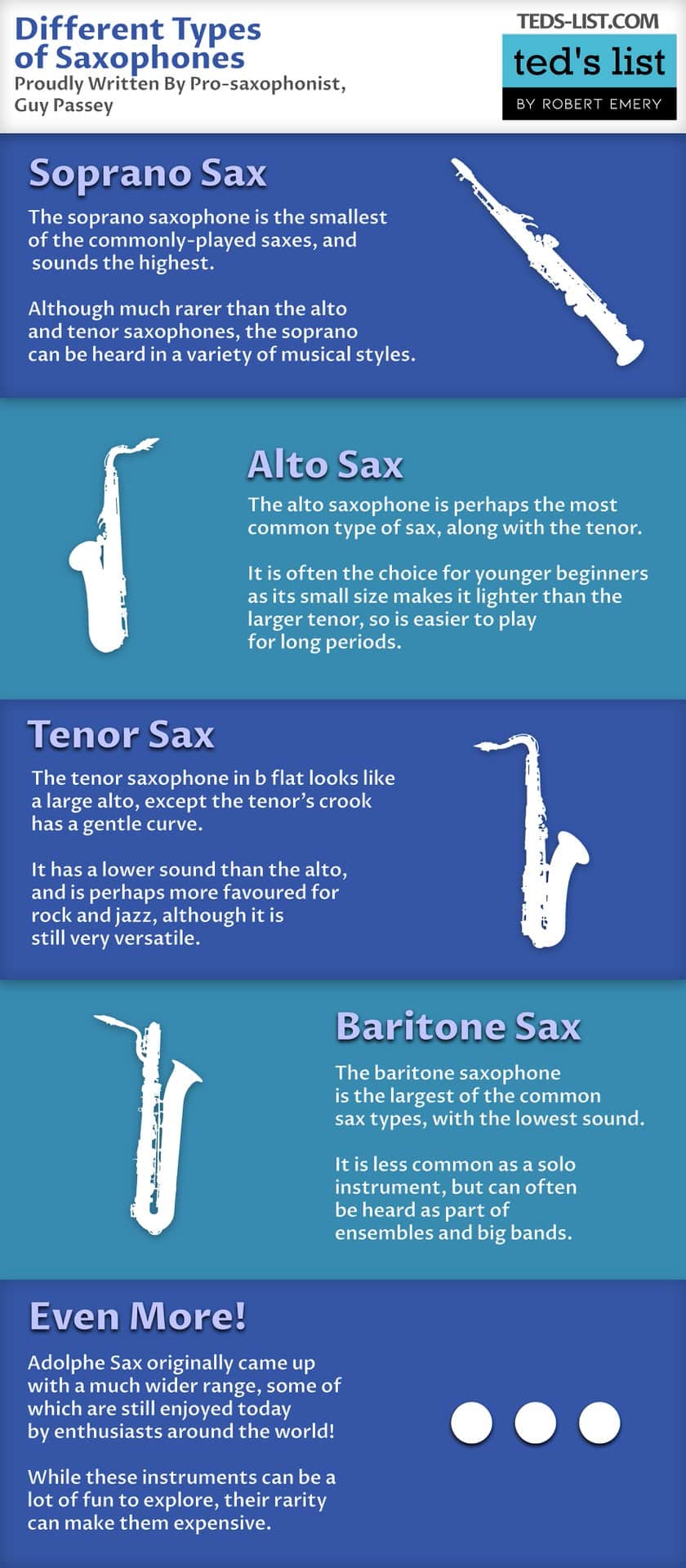Saxophones truly enchant anyone who hears them! Their unmistakable shape and one-of-a-kind sound pop up everywhere you look, from smoky jazz clubs to grand orchestral shows and even the latest pop tunes.
Budding saxophonists might know that there are a few different types of saxophones out there, so how to know which one to choose?
History of the saxophone
The saxophone was invented by Belgian instrument maker inventor Adolphe Sax in 1846.
Sax’s idea was to combine the power of brass instruments with the agility and speed that was possible on woodwind instruments. He had them in mind for marching bands and military bands. He designed a cone-shaped brass body for added volume, added keys that gave it the agility of the flute, and a mouthpiece and reed setup very similar to the clarinet.
He originally created seven different sizes of saxophone, ranging from the high sopranino down to the huge contrabass saxophone. The most popular however were the middle four instruments; the soprano, alto, tenor and baritone, which have been used in numerous styles of music, and are still in mass production today. They are commonly found in jazz bands and concert bands, as well as chamber music (such as saxophone quartets), and occasionally in an orchestra.

Anatomy of the saxophone
All saxophones have three main components: the body, the neck (or crook), and the mouthpiece/reed.
The reed is a thin piece of cane, which is attached to the mouthpiece with a metal (sometimes leather) cylinder called the ligature.
Breathing in and then blowing into the mouthpiece causes the reed to vibrate, creating a sound wave.
The neck connects the mouthpiece to the body, which is basically just a metal tube with holes in it.
Most saxophones have a bend about two thirds of the way down, and the bottom section of the tube (the ‘bell’) points upwards again.
Each hole in the body has a key over it. The keys allow the saxophonist to close and seal different holes with their fingers as they blow, creating different notes.

The four main types of saxophone
Although Adolphe Sax created many different saxophone with varying sizes, there are only four which are in common usage today: soprano, alto, tenor and baritone.
Each of the different saxophone sizes has the same basic construction and the same key layout, so transferring between them is fairly straightforward.
Soprano Sax
Yamaha YSS475II
Soprano Saxophone

FEATURES: Good Yamaha build quality
OTHER INFO: Intermediate Level
Yamaha YSS475II
Soprano Saxophone
- Reasonably priced for a pro-style soprano sax
- Includes a good mouthpiece (4C) and a travel bag
- Not as tonally sophisticated as full professional models
When you click ‘Check Price’, you’ll see there are loads of great places to buy this item. Our personal favorite is Sweetwater for the US, and Thomann and Gear4Music for the UK & Europe.
They are the largest music retailers, with excellent customer service, competitive prices, really fast shipping, and the longest guarantees.
The professional musician who wrote this article combined many things,
from the product build, manufacturer’s reputation through to feedback
from other users, to create our famous TedScore™.
The soprano saxophone is the smallest of the commonly-played saxes, and sounds the highest.
It is sometimes made with a curved bell like the more common alto and tenor, but most often it is constructed totally straight, appearing a bit like a metal clarinet.
Although much rarer than the alto and tenor saxophones, the soprano can be heard in a variety of musical styles.
Famous soprano saxophone recordings include Englishman In New York by Sting, My Favourite Things by John Coltrane, or Ravel’s Bolero from the orchestral world.
Soprano saxophones are perhaps the hardest to master, and saxophonists normally start on alto or tenor first before exploring it.
Alto Sax
Yamaha YTS280
Alto Saxophone

FEATURES: Excellent intonation
OTHER INFO: Intermediate Level
Yamaha YTS280
Alto Saxophone
- Can be used from beginner up to ABRSM grade 8 level
- Includes backpack-style case and mouthpiece
- On the pricier side for a student saxophone
When you click ‘Check Price’, you’ll see there are loads of great places to buy this item. Our personal favorite is Sweetwater for the US, and Thomann and Gear4Music for the UK & Europe.
They are the largest music retailers, with excellent customer service, competitive prices, really fast shipping, and the longest guarantees.
The professional musician who wrote this article combined many things,
from the product build, manufacturer’s reputation through to feedback
from other users, to create our famous TedScore™.
The alto saxophone is perhaps the most common type of sax, along with the tenor. It is larger than the soprano, and although straight versions do exist, it is usually constructed with a curved bell at the bottom.
The alto sax is the instrument of choice for many pop musicians, and famous solos are played by alto saxophonists on the iconic Baker Street by Gerry Rafferty, and Billy Joel’s Just The Way You Are.
The alto sax has the versatility to play a huge variety of musical styles however, and can be heard in classical, jazz, rock and many others.
It is often the choice for younger beginners as its small saxophone size makes it lighter than the larger tenor, so is easier to play for long periods.
Tenor Sax
Yamaha YTS280
Tenor Saxophone

FEATURES: Excellent intonation
OTHER INFO: Intermediate Level
Yamaha YTS280
Tenor Saxophone
- Can be used from beginner up to ABRSM grade 8 level
- Includes backpack-style case and mouthpiece
- On the pricier side for a student tenor saxophone
When you click ‘Check Price’, you’ll see there are loads of great places to buy this item. Our personal favorite is Sweetwater for the US, and Thomann and Gear4Music for the UK & Europe.
They are the largest music retailers, with excellent customer service, competitive prices, really fast shipping, and the longest guarantees.
The professional musician who wrote this article combined many things,
from the product build, manufacturer’s reputation through to feedback
from other users, to create our famous TedScore™.
The tenor saxophone in b flat looks like a large alto, with the only obvious difference being that the tenor’s crook has a gentle curve.
It has a lower sound than the alto, and is perhaps more favoured for rock and jazz, although it is still very versatile. You can hear the tenor saxophone players on such famous tunes as The Girl from Ipanema and, of course, The Pink Panther!
Baritone Sax
Trevor James Classic II
Baritone Saxophone

FEATURES: Excellent intonation
OTHER INFO: Full baritone range of low A
to high F sharp
Trevor James Classic II
Baritone Saxophone
- Very reasonably priced for a baritone
- Plenty of accessories included as standard
- Lacks the tone and intonation of a full professional model
When you click ‘Check Price’, you’ll see there are loads of great places to buy this item. Our personal favorite is Sweetwater for the US, and Thomann and Gear4Music for the UK & Europe.
They are the largest music retailers, with excellent customer service, competitive prices, really fast shipping, and the longest guarantees.
The professional musician who wrote this article combined many things,
from the product build, manufacturer’s reputation through to feedback
from other users, to create our famous TedScore™.
The baritone saxophone is the largest of the common saxophone types, with the lowest sound.
The length of the tube requires a more curved construction than the others to make it practical to carry around, so the baritone has a much longer bell at the bottom, and an intricately twisted neck at the top.
It is less common as a solo instrument than the alto or tenor, but can often be heard as part of ensembles and big bands, and is famously featured on tracks such as this amazing version of Moanin’. The baritone sax is also the type of saxophone played by Lisa Simpson!
Other members of the saxophone family
Although these four different kinds of saxophones are by far the most common, Adolphe Sax originally came up with a much wider range, some of which are still enjoyed today by enthusiasts around the world (such as the bass saxophone, which is slightly larger than the baritone).
At the top of the range above the soprano there are the tiny sopranino and soprillo saxes, and at the bottom below the baritone can be found the huge bass and contrabass saxes.
There are also unusual instruments in the middle of the range, such as the C melody saxophone, which sits between the alto and tenor, and was very popular in the early 20th century.
While these instruments can be a lot of fun to explore, their rarity can make them expensive. There is also a lot less ensemble music written for them, so if playing in a group is of interest to you, it’s advisable to stick to one of the main four in most cases.
Recommended saxophone type for the child beginner
Trevor James‘The Horn’
alto saxophone

FEATURES: Excellent intonation
OTHER INFO: Reliable Alto Sax
Trevor James‘The Horn’
alto saxophone
- Good value for a new instrument
- The supplied case is nice and sturdy
- Doesn’t play quite as well as some of the other student instruments
When you click ‘Check Price’, you’ll see there are loads of great places to buy this item. Our personal favorite is Sweetwater for the US, and Thomann and Gear4Music for the UK & Europe.
They are the largest music retailers, with excellent customer service, competitive prices, really fast shipping, and the longest guarantees.
The professional musician who wrote this article combined many things,
from the product build, manufacturer’s reputation through to feedback
from other users, to create our famous TedScore™.
The best saxophone for a child to start on is almost always the alto. It is lighter than the tenor, much easier to get to grips with than the soprano, and provides a great platform to learn the fundamentals.
It is quite common for students to start on alto, then transfer to another sax if they prefer when they are a bit older.
Recommended saxophone type for the adult beginner
Trevor James‘The Horn’
tenor saxophone

FEATURES: Excellent intonation
OTHER INFO: Consistent, reliable construction
Trevor James‘The Horn’
tenor saxophone
- Good value for a new instrument
- The supplied case is nice and sturdy
- Doesn’t play quite as well as some of the other student instruments
When you click ‘Check Price’, you’ll see there are loads of great places to buy this item. Our personal favorite is Sweetwater for the US, and Thomann and Gear4Music for the UK & Europe.
They are the largest music retailers, with excellent customer service, competitive prices, really fast shipping, and the longest guarantees.
The professional musician who wrote this article combined many things,
from the product build, manufacturer’s reputation through to feedback
from other users, to create our famous TedScore™.
For an adult beginner alto and tenor saxophone are both great choices, and there are numerous good student models available to choose from.
People don’t often begin on baritone, as the size and weight do make it physically demanding, and there are also fewer student models available, leaving pricey professional instruments as the only option.
I wouldn’t recommend soprano for adult beginners either, as it requires quite a refined technique to make a nice sound. If you like the sound of the soprano, get stuck into the alto first and then you can easily switch later on.
The saxophone in genres of music
Saxophonists can be found right across the musical spectrum. Jazz is of course the instrument’s spiritual home, and it is very comfortable in rock and pop.
Increasingly the saxophone is becoming more prominent in classical music, with a growing range of superb repertoire to play for soloists and ensemble players alike.
Fundamentally the saxophone is incredibly versatile, with changes to technique, mouthpiece and reeds allowing a huge range of different sounds to be produced, and this allows saxophones to be at home in almost any genre you can think of.
The importance of a good mouthpiece
Yamaha 4C Saxophone
Mouthpiece

FEATURES: Best Mouthpiece
OTHER INFO:Reliable, consistent construction
Yamaha 4C Saxophone
Mouthpiece
- Reasonably priced
- Good quality
- Sound not as refined as a professional model
When you click ‘Check Price’, you’ll see there are loads of great places to buy this item. Our personal favorite is Sweetwater for the US, and Thomann and Gear4Music for the UK & Europe.
They are the largest music retailers, with excellent customer service, competitive prices, really fast shipping, and the longest guarantees.
The professional musician who wrote this article combined many things,
from the product build, manufacturer’s reputation through to feedback
from other users, to create our famous TedScore™.
The mouthpiece and reed create the sound of the saxophone – the body just amplifies it. So getting these elements right when sorting your equipment is hugely important.
A mouthpiece needs to be shaped precisely to produce a good sound, and a cheaply made or unbranded mouthpiece will likely sound poor and inconsistent.
Fortunately, decent mouthpieces are not expensive. A Yamaha 4C, for example, costs £30-35 and is manufactured to a consistent standard, so you won’t need to upgrade for 5 years in most cases.
The importance of good quality reeds
Juno by Vandoren
Saxophone Reeds

FEATURES:Quality Reeds
OTHER INFO: Specially designed for ease of playing
Juno by Vandoren
Saxophone Reeds
- Good tone production
- Trusted brand
- Not always as consistent as other brands
When you click ‘Check Price’, you’ll see there are loads of great places to buy this item. Our personal favorite is Sweetwater for the US, and Thomann and Gear4Music for the UK & Europe.
They are the largest music retailers, with excellent customer service, competitive prices, really fast shipping, and the longest guarantees.
The professional musician who wrote this article combined many things,
from the product build, manufacturer’s reputation through to feedback
from other users, to create our famous TedScore™.
Similarly, reeds are not the place to economize. Bad reeds will make playing tiring and unrewarding. An established brand such as Vandoren Juno is the way to go.
Different Types Of Saxophones
Summary
The saxophone is a fantastically rewarding instrument to learn, and can lead you into great playing experiences in all sorts of styles of music.
Think carefully about which type of sax will suit you best depending on your age, experience and tonal preferences, and you’ll be well set to find an instrument you’ll take pleasure in for many years.

BEST saxophone for child beginners
Trevor James 'The Horn' Alto Saxophone
A great value first saxophone

BEST Saxophone For Adult Beginners
Trevor James 'The Horn' Tenor Saxophone
A quality first instrument without breaking the bank

BEST Beginner Mouth piece
Yamaha 4C Alto Saxophone Mouthpiece
A solid and reliable mouthpiece from one of the world’s top musical instrument brands.
FAQ's
The four main types of saxophone are soprano, alto, tenor and baritone.
Soprano is probably the hardest to sound good on for a beginner
Alto and tenor are best for beginners, and for younger beginners alto is the best choice. Otherwise, it’s all about your preference. Listen to some recordings and see which tone you prefer!
What makes each type of saxophone unique is the size, shape and tone. Baritones are very large and have a much more curled up tube, whereas sopranos are much smaller and usually completely straight
The four main types of saxophone are soprano, alto, tenor and baritone.
Alto and tenor are best for beginners, and for younger beginners alto is the best choice. Otherwise, it’s all about your preference – listen to some recordings and see which tone you prefer!
A bass saxophone is one of the largest members of the saxophone family, standing at over 6 feet tall when fully assembled. It has a large, conical body and a curved neck that extends upwards, making it a challenging instrument to play and transport.
The length of a saxophone varies depending on the type and model, but a soprano saxophone typically measures around 30 inches long, while a baritone saxophone can measure up to 6 feet long. The length of a saxophone is determined by the length of its tubing, which produces its unique sound.












Interesting fact: unlike other popular musical instruments, the saxophone was invented by a single person, Adolphe Sax, who survived many accidents in his childhood. He also created fourteen different types of saxophones, but only four are commonly used today.
Very true Sarah! Thanks for that…
Does it really matter what type of Saxophone it is? I think they are all the best!
Well certain sax’s are more difficult to play, and it depends what rep and style of music you’d like to play. But I do agree, all sax’s are brilliant!
If you enjoyed this article, please do let us know below! Or if you have any article requests, don’t be shy!